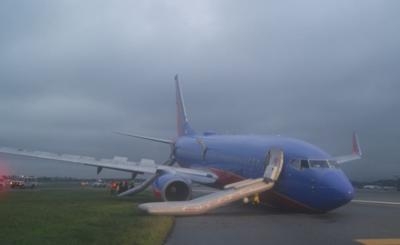Wed, Nov 12, 2014
Co-Pilot Was Flying The Aircraft At the Time, According To NTSB Documents
Documents released by the NTSB shows that the captain of a Southwest Airlines 737 landing at LaGuardia airport in New York pulled the power back during the approach while the co-pilot was flying the airplane, a violation of company and industry safety protocols.

The plane's nose gear collapsed when the airplane landed nose-first on the runway. Everyone was evacuated from the airplane, and nine suffered non-life-threatening injuries. Traffic was snarled at LaGuardia for several hours.
According to the documents posted on the NTSB's accident docket, the captain of the airplane placed her hand over the co-pilot's hand on the throttles and pulled them back unexpectedly. She did not announce that she was taking control of the airplane ... "I got it" ... until it was about 50 feet above the runway, according to a report from the Wall Street Journal.
The 49-year-old captain was fired by Southwest about two months after the incident. At the time, she had more than 7,500 hours flying 737s. The NTSB indicates that about three years before the incident, she was required by the airline to take remedial training because of her management style. First Officers reportedly complained regularly about her "overbearing attitude" in the cockpit.
The co-pilot is still flying for Southwest.
The captain had initially disputed the account of the accident given to the NTSB by the co-pilot, but the data from the Cockpit Voice Recorder backed up the co-pilot's story.
According to the NTSB's documents, the captain became concerned that the airplane was too high on the approach and suddenly pulled back power to the engines at about 100 feet. With the flaps extended, the airplane nosed down, and she was unable to recover before the nose gear hit the runway. The force of the impact was calculated to be about three times the weight of the airplane ... all on the nose gear ... and the plane skidded for nearly 20 seconds down the runway.
(Image provided by the NTSB)
More News
Aero Linx: Model Aeronautical Association of Australia MAAA clubs are about fun flying, camaraderie and community. For over 75 years, the MAAA has been Australia’s largest fl>[...]
Touchdown Zone Lighting Two rows of transverse light bars located symmetrically about the runway centerline normally at 100 foot intervals. The basic system extends 3,000 feet alon>[...]
“Discovery and innovation are central to our mission at Virgin Galactic. We’re excited to build on our successful record of facilitating scientific experiments in subor>[...]
How To Get A Story On Aero-TV News/Feature Programming How do I submit a story idea or lead to Aero-TV? If you would like to submit a story idea or lead, please contact Jim Campbel>[...]
Student Pilot Reported That During Rotation, “All Of A Sudden The Back Of The Plane Kicked To The Right..." Analysis: The student pilot reported that during rotation, “>[...]
 ANN's Daily Aero-Linx (05.02.24)
ANN's Daily Aero-Linx (05.02.24) ANN's Daily Aero-Term (05.02.24): Touchdown Zone Lighting
ANN's Daily Aero-Term (05.02.24): Touchdown Zone Lighting Aero-News: Quote of the Day (05.02.24)
Aero-News: Quote of the Day (05.02.24) ANN FAQ: Contributing To Aero-TV
ANN FAQ: Contributing To Aero-TV NTSB Final Report: Cirrus Design Corp SR20
NTSB Final Report: Cirrus Design Corp SR20



